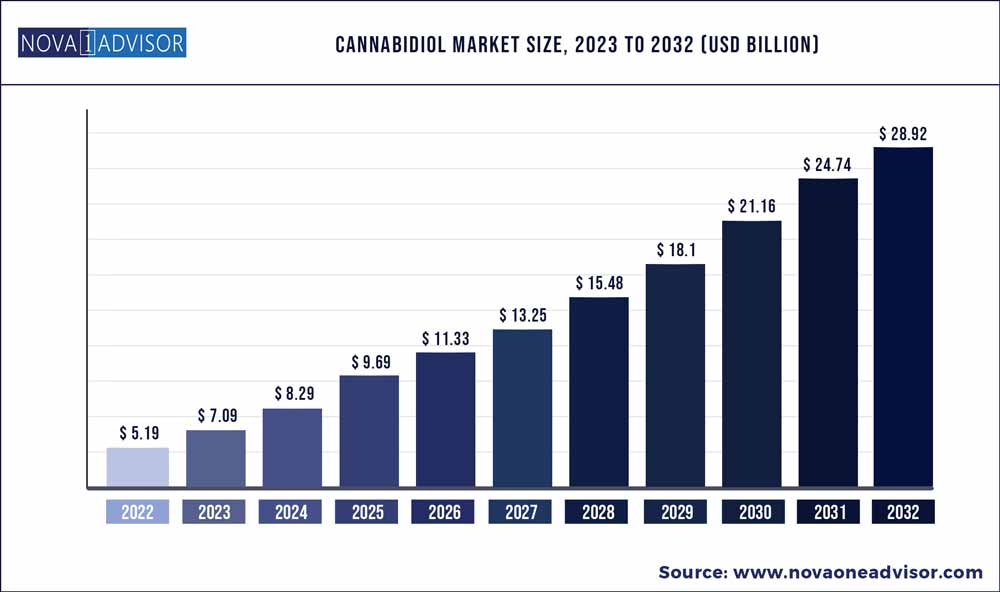The global cannabidiol market size was exhibited at USD 5.19 billion in 2022 and is projected to hit around USD 28.92 billion by 2032, growing at a CAGR of 16.9% during the forecast period 2023 to 2032.

Key Pointers:
- The marijuana segment dominated the market and accounted for a revenue share of over 51.0% in 2022.
- The Business to Business (B2B) segment dominated the market and accounted for a revenue share of over 52.1% in 2022.
- In B2B end use, the pharmaceuticals sub-segment dominated the market and accounted for a revenue share of over 71.0% in 2022.
- In 2022, North America dominated the market with a revenue share of over 86.0% and will continue to retain its leading position in the market.
- In 2022, the medical end-use segment accounted for the largest revenue share owing to the rising use of cannabis derivatives for various medical conditions.
- North America accounted for the largest revenue share in 2022 and is expected to maintain its lead over the forecast period. Favorable regulations, increasing awareness about CBD oil, growing consumer preference, and a rise in the number of manufacturers are the factors expected to fuel market growth in the region
Cannabidiol Market Report Scope
| Report Coverage |
Details |
| Market Size in 2023 |
USD 9.15 Billion |
| Market Size by 2032 |
USD 13.16 Billion |
| Growth Rate from 2023 to 2032 |
CAGR of 4.12% |
| Base Year |
2022 |
| Forecast Period |
2023 to 2032 |
| Segments Covered |
Source type, sales type, end-use, region |
| Regions Covered |
North America, Europe, Asia-Pacific, Latin America and Middle East & Africa |
Increasing awareness regarding the health benefits of cannabidiol (CBD), changing consumer opinion, and the attitude toward CBD products are some of the key factors driving the demand for these products. Cannabidiol is a chemical compound that is found in the cannabis Sativa plant, and is extracted from hemp or cannabis, generally from hemp due to its naturally high CBD content. The cannabis Sativa plant has over 80 chemicals that are identified as cannabinoids. Out of all the chemicals, cannabidiol is most widely used for medical purposes due to its lack of psychoactive effect.
Cannabidiol oil is used in various medical applications to treat disorders including anxiety and depression and is also used for stress relief, cancer symptom relief, inflammation, and diabetes prevention. The recent COVID-19 pandemic has affected many industries around the world, including the CBD industry. The impact of COVID-19 has led to disruption in production processes. Due to strict quarantine measures taken across the globe, there is a stagnation in the supply of products, including CBD products. In addition, most of the retail stores are currently closed due to the pandemic. Hence, the marketplace may face a slowdown amidst the pandemic, however, it can gain momentum in 2021 due to the increase in demand for CBD-based products in the coming years.
The global market is expected to develop at a lucrative rate over the forecast period owing to the increased acceptance of CBD-based products to treat diseases. There is a growing need for nutrient-rich foods to help people achieve fitness objectives and avoid problems such as inflammation and pain. Furthermore, the Center for Food Safety (CFS) assesses companies that sell CBD-based products based on their manufacturing process, processing procedures, testing processes, and customer openness. Such government activities piqued consumer interest, resulting in increased uptake of CBD-based products.
The introduction of CBD-infused goods is a priority for major industry players. CBD oil is a non-psychoactive and legal component of hemp that can be used in a variety of industries, including food, health products, pharmaceuticals, and cosmetics. To capture a large revenue share in the CBD market, the industry players are expected to use organic and inorganic methods such as mergers, acquisitions, and new product introduction. In June 2021, Vertical Wellness announced that it has agreed to merge with CanaFarma Hemp Products Corp., a Canada-based company that offers multiple products and services related to hemp. After the merger, Vertical Wellness, a U.S.-based cannabidiol company, would transform into a public entity with a combined worth of USD 50 million.
Some of the prominent players in the Cannabidiol Market include:
- ENDOCA
- Cannoid, LLC
- Medical Marijuana, Inc.
- Folium Biosciences
- Elixinol
- NuLeaf Naturals, LLC
- Isodiol International, Inc.
- Pharmahemp d.o.o.
Segments Covered in the Report
This report forecasts revenue growth at global, regional, and country levels and provides an analysis of the latest industry trends in each of the sub-segments from 2018 to 2032. For this study, Nova one advisor, Inc. has segmented the global cannabidiol market.
By Source Type
By Sales Type
- B2B
- By End-use
- Pharmaceuticals
- Wellness
- Food & Beverages
- Personal Care & Cosmetics
- Nutraceuticals
- Others
- B2C
- By Sales Channel
- Hospital Pharmacies
- Online
- Retail Stores
- By End-use
- Medical
- Chronic Pain
- Mental Disorders
- Cancer
- Others
- Personal Use
By End-use
- Medical
- Chronic Pain
- Mental Disorders
- Cancer
- Others
- Personal Use
- Pharmaceuticals
- Wellness
- Food & Beverages
- Personal Care & Cosmetics
- Nutraceuticals
- Others
By Region
- North America
- Europe
- Asia-Pacific
- Latin America
- Middle East & Africa (MEA)

